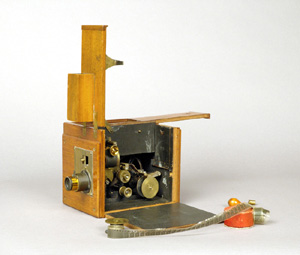 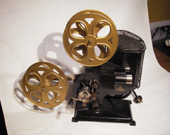 |
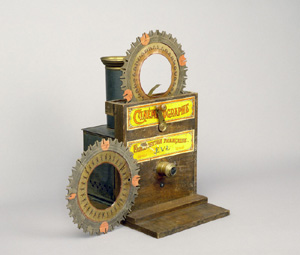 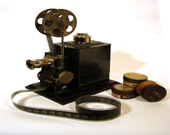 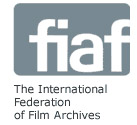
|
|---|
|
A total of 244 participants (156 from foreign countries outside Japan
representing 36 nations and 88 institutions, and 88 from Japan)
attended the 63rd FIAF Congress
Tokyo 2007, organized by F.I.A.F. and the National Museum of Modern
Art Tokyo-National Film Center, which created an ideal atmosphere for
international film archive communication. A variety of issues were addressed
at the Congress in its "Symposium",
"Second Century Forum" and film exhibitions.
At the Symposium, the Fukuoka City Public Library Film Archive presented
a paper on narrow gauge films in Japan centered on 8mm film. During
the film exhibitions, the Fukuoka City Public Library Film Archive introduced
"The Princess of Baghdad", Japan's first post-war
feature animation which was jointly restored with the National Museum
of Modern Art Tokyo-National Film Center. The Opening Reception as well
as breaktime recesses provided during the presentations also served
as important grounds for communication on an international scale. |
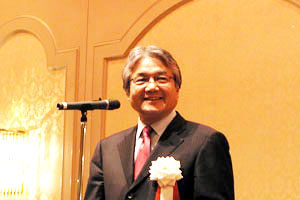 |
 |
|---|---|
| Tamotsu Aoki, Commissioner Agency of Cultural Affiars |
Eva Orbanz President, FIAF |
 |
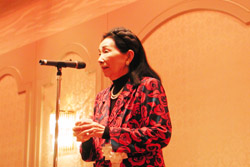 |
| Tetsuo Tsujimori, Director National Museum of Modern Art-Tokyo |
Etsuko Takano, Honorary Director National Museum of Modern Art Tokyo National Film Center |
|
At the Opening Reception , congratulatory
remarks were presented by Tamotsu Aoki, Commissioner of the Agency
of Cultural Affairs of the Japanese government, Eva Orbanz, President
of F.I.A.F., Testuo Tsujimori, Director of the National Museum of
Modern Art Tokyo and Etsuko Takano, Honorary Director of the National
Museum of Modern Art Tokyo- National Film Center. During his address,
Commissioner Aoki made a point in referring to the Fukuoka City
Public Library Film Archive as an "extremely precious and important
film archive in Japan".
|
|---|
The
Opening Reception attended by film archivists from around the world,
turned into an exciting get together where the universal theme of "film
preservation" overcame differences in language and culture. |
|---|
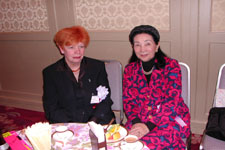 |
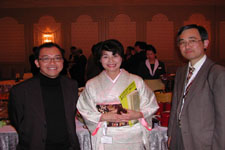 |
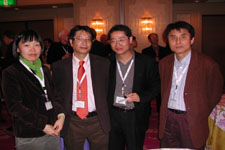 |
|---|
FIAF
President Eva Orbanz (left) and Etsuko Takano, Honorary Director of
the National Museum of Modern Art Tokyo- National Film Center, have
a pleasant seated conversation during the opening reception. |
Richie
Lam, Director of the Hong Kong Film Archive (left), Tomiko Ueki, Chief
Executive of the Fukuoka City Public Library (middle) and Yoshiyuki
Yahiro, Curator, Fukuoka City Public Library Film Archive (right). |
Keiji
Matsumoto, Film Preservationist at the Fukuoka City Public Library Film
Archive (second from the left) converses with the delegation from the Korean Film Archive including Sungji Oh (on the very left). |
|---|
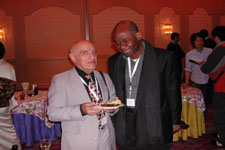 |
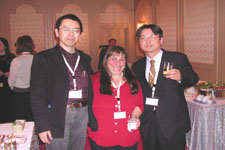 |
 |
|---|
Abdullah Ommidvar, President of Fundacion Chilena de las Imagenes en Movimento of Chile (left) has a pleasant conversation over refreshments during the opening reception with Afonso Antonio, Director Geral of the Cinemateca Nacional de Angola under the Ministry of Culture of the Republic of Angola (right). |
Nancy
Goldman, Head of the Pacific Film Archive Library and Film Study Center
of the University of California, Berkeley in California USA is in between
Akira Tochigi, Curator of Film at the National Museum of Modern Art
Tokyo-National Film Center (left) and Hisashi Okajima, Head of the National
Museum of Modern Art Tokyo- National Film Center. |
Robert
Daudelin, formerly the Directeur Generale of the Cinematheque Quebecoise
of Quebec, Canada with his lovely wife who visited Japan for the first
time. Mr. Daudelin presently serves F.I.A.F. as the editor-in-chief
of the "Journal of Film Preservation", a F.I.A.F.
publication dedicated to the cause of film preservation. |
|---|
|
There was ample opportunity for communication
at the Congress, including the 15 minute break time periods which came
with coffee, tea and refeshments. These break time periods produced
many heated discussions providing participants with an opportunity to
meet other participants face to face. |
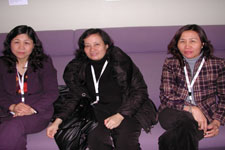 |
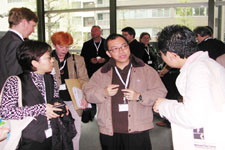 |
 |
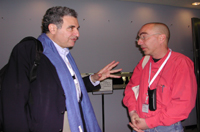 |
|---|
| The
Vietnamese delegation led by Dr. Hoang Nhu Yen, Director of the Vietnam
Film Institute. |
Richie
Lam in a heated discussion with his fellow delegates from the Hong Kong
Film Archive. |
Steve
Higgins of NY's Museum of Modern Art Department of Film and Media (left)
posing with Hisashi Okajima, Head of the National Museum of Modern Art
Tokyo- National Film Center. |
Serge
Toubiana, Director General of the Cinematheque Francais (left) talking
with Paulo Cherchi Usai, Director of SoundScreen Australia.(right). |
|---|
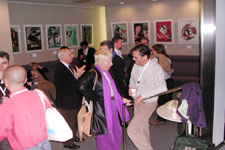 |
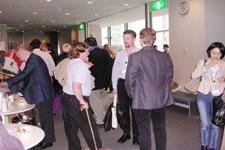 |
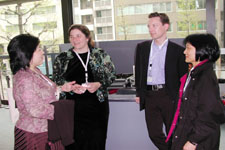 |
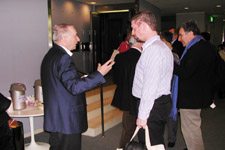 |
|---|
Break time
over coffee and tea always provided a casual, relaxing atmosphere. Yet
even here, there were heated discussions and exchange of opinion on
the issue of film preservation, so much so that often these discussions
went beyond the 15 minute break time. |
|---|
|
The Congress "Symposium"
and "2nd Century Forum" were held
in the "Grand Hall" where a wide spectrum of papers and lectures
were presented. Visual images were projected on to the giant screen
of the hall as part of the presentations. Content of the papers and
lectures were simulaneously interpreted into English, French, Spanish
and Japanese. Q&A and exchange of opinion sessions followed the
presentations |
 |
 |
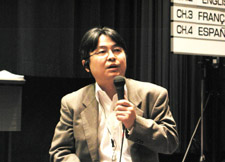 |
|---|
Nikolaus
Wostry (Filmarchiv Austria, Wien) delivers a lecture on "Early
Nitrate Material and Historical Projection". |
Discussing
issues from left to right: Vladimir Opela, Director and Curator of Nardodni
Filmovy Archiv (Czech Republic) and Chrisian Dimitriu, Senior Administrator
at F.I.A.F. |
Hisashi
Okajima, Head of the National Museum of Modern Art Tokyo-National Film
Center was very active, presenting opening remarks at the Congress as
well as posing questions at the Q&A sessions. |
|---|
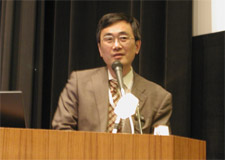 |
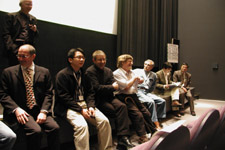 |
 |
|---|
Yoshiyuki
Yahiro of the Fukuoka City Public Library Film Archive presenting his
paper on "Preservation of Narrow Gauge Films in Japan A Case
Study of 8mm Films”. |
After
the presentation of papers and lectures, special Q&A sessions followed
allowing exhanges in opinion between the speakers and the audience.
|
Microsoft
Powerpoint was frequently used to project visual images on to the screen
during presentations. |
|---|
 |
 |
|---|
Inside
the hall where papers were presented with visual images. Note the simutaneous
interpretation booth (white) on the left. |
Receptionists
in charge of interpretation receivors (which transmitted interpreation
in English, French, Spanish and Japanese). |
|---|